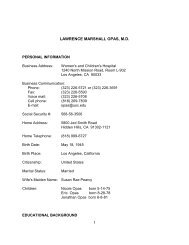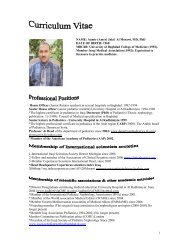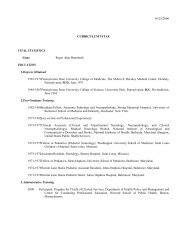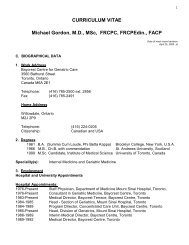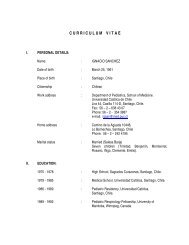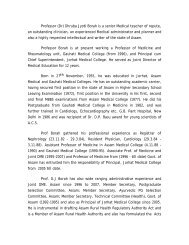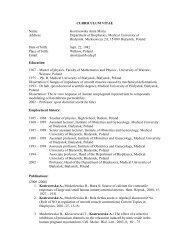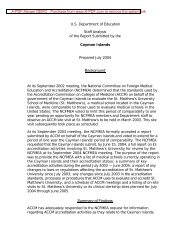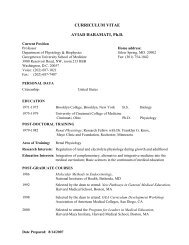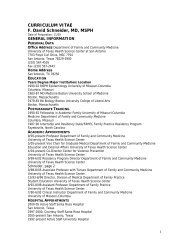CURRICULUM VITAE Diane Elissa Heestand - IAOMC
CURRICULUM VITAE Diane Elissa Heestand - IAOMC
CURRICULUM VITAE Diane Elissa Heestand - IAOMC
Create successful ePaper yourself
Turn your PDF publications into a flip-book with our unique Google optimized e-Paper software.
Education:Indiana University, Ed.D. ’79, Major: Instructional Systems Technology—MessageDesign. Minors: American Studies and General CommunicationUniversity of Alabama in Birmingham, 1979-81, 21 hours in the MPH Program inthe Health Education TrackUniversity of Arkansas for Medical Sciences, College of Public Health, 2001 topresent, 33 hours completed in the MPH program in Health BehaviorUniversity of Southern California, 1991, Certificate in Management EffectivenessUniversity of Wyoming, M.A. ’68, Major: American CivilizationAllegheny College, B.A. ’67, Major: International Political ScienceHigh School Diploma, ’63, Old Fort High School, Old Fort, OhioConsultations Visiting Professor of Medical Education, University of Jos, Faculty of Medicine,Fellowships Jos, Nigeria, September 2005 – January 2006.AssistantshipsVisiting Professor of Medical Education, University of Nigeria College of Medicine,Enugu, Nigeria, February 2006—June 2006.Mentor to ECFMG Medical Education Fellows: Jia He (May-November, 1999)and Khamphong Nammavongmixay (September, 2000-July, 2001)Coordinator of the China/United States Professional Exchange Program atMercer University School of Medicine, Macon, GA, 1986-87HOPE Fellow, April 13—June 27, 1986. The Learning Resources Center Project,Zhejiang Medical University, Hangzhou, People’s Republic of ChinaMedia Consultant, September, 1982. Veterans Administration Southeast RegionalMedical Education Center, Birmingham, AL.Media Consultant, June, 1975. Lincoln University, Lincoln, PA.Graduate Assistantship, Summer, 1974. Indiana University Audio-visual Center,Graphics DepartmentGraduate Assistantship, 1969-70. Indiana University, National EducationalTelevision Film ServiceResident Assistantship, 1968-69. Indiana University, Forest Hall DormitoryResident Assistantship, 1967-68. University of Wyoming, White HallTeaching Assistantship, 1967-68. University of Wyoming, Department of HistoryCourses:Teaching Scholars—a series of monthly seminars (9) and an independent projectcompleted during the second year. The program has been held each year since1996 Participants may receive graduate credit through the Department ofEducational Leadership at the University of Arkansas at Little Rock.3
Web-based Learning Support Steering Committee (chair)Academic Support Management GroupAcademic Computing Advisory CommitteeTeaching Scholars Steering Committee (chair)College of Medicine Teaching Awards CommitteeUAMS IRBSOAR (Scholarship of Academic Responsibilities) Steering CommitteeAssociations: Association for Educational Communications and Technology, 1971 to presentPresident-elect, President, Past President—Media Design and ProductionDivision, 1984-87Secretary—Media Design and Production Division, 1982-84Secretary, National Affiliates Council, 1988-89Chair, Affiliated Organizations Council, 1989-90Board Member, Division of Educational Media Management, 1990-92Reviewer of Proposals for Annual Meeting, 1983, 1984, 1987, 1996, 1997Member, Host State Committee, 1986-87Member, Evaluation of Instructional Materials Committee, 1987Member, 1993 Convention Task Force, 1992Coordinator of Health SIG, 1996-98Health Sciences Communications Association, 1980 to presentPresident-elect, President, Past President, 1987-1990Program Chair for 1992 Annual Meeting, 1990-1992Reviews Editor for JBC, 1990-92Editorial Review Board for JBC, 1993-95Chair, Nominations Committee, 1990-91Board of Directors, 1982-86Chair, Education Committee, 1983-85Chair, Continuing Education Subcommittee, 1982-83Member, Evaluation Subcommittee, 1980-81Member, HeSCA/COMMTEX Program Committee, 1986-87Member, Bylaws Committee, 1982-84Chair, HeSCA/COMMTEX Program Committee, 1986-87Co-Chair of Past Presidents’ Leadership Development Fund, 1991 to 1992Chair, Awards Committee, 1993-95Chair, BPA/HeSCA Merger Task Force on Awards, 1995Evaluation of Annual Meeting, 1996Liaison with AECT, 1996-97Group on Educational Affairs of the Association of American Medical Colleges, 1997to presentMember of RIME (Research in Medical Education) SectionChair of RIME for the Southern Group on Educational Affairs, 1998-00Member of the Continuing Medical Education SectionReviewer of GEA Proposals for Small Group Discussions or Workshops 1998 topresentCo-Chair of SGEA 2001 Meeting in Little RockReviewer of SGEA Proposal, 2000 to presentReviewer of SGEA Outstanding Presentation, 2004Generalists in Medical Education, 1983 to presentImmediate Past Chair, 2000-01Chair, 1999-005
6. River Information System data - similar to the Washington River Information System (WARIS) programdata.7. Natural Heritage System data - specific information on element occurrences of all monitor, sensitive,threatened and endangered species.8. Major watershed and sub-watershed boundaries.9. LANDSAT thematic mapper satellite imagery covering the study area.10. Detailed transportation system data compiled from all available sources.11. Soil and geology GIS layers.12. Range maps for all vertebrate species.13. Population status maps for important sensitive, threatened and endangered species.14. Status maps for aquatic species.15. Human population centers and population density (from US Census data).Step 2 - Derived Data Layers - Determination of Biodiversity ValuesAnalysis of the above data sources can yield derived data layers which reflect various dimensions of thebiodiversity value or potential of the landscape. These data layers are assembled to provide input into a rasterbased GIS biodiversity value surface model. The following derived layers are important elements to this surfacemodel.Distribution and Fragmentation of Native Forests.A GIS layer is developed which contains data on the distribution of managed and unmanaged forests. Asimplified management intensity attribute code is developed from management history data. The best existingdata sources are merged to create a unified forest cover layer which best reflects the current status of managedand unmanaged forests in the study area.Habitat fragmentation of patches of remaining forest is evaluated through several measures. Patch size andarea/perimeter ratios of remaining native forest patches are calculated. Native forest patches are weighted withlarge patches with low perimeter to area ratios receiving the highest rank. An edge density surface is developedfor edges resulting from human created openings in natural forests. This is developed through a moving windowanalysis, with the analysis window size set by the average home range of the important edge sensitive speciesin the study area. The resulting surface is weighted so that areas of native forest with low edge density receivethe highest weighting.Degree of Late Successional Forest Development.Forest condition data is analyzed to proved information on the degree of development of late successional forestconditions within stands in the study area. This grid is smoothed with a 500 meter mean filter to reflect theaverage degree of development of late successional forest characteristics in the landscape. The resultingsurface is weighted to reflect the degree to which late successional forests contribute to regional biodiversity.Patch Size Evaluation of Late Successional Forest Stands.The above GIS layer on late successional forests is analyzed to calculate patch size, connectivity and proximityof late successional forest stands. A GIS grid is created which is weighted by stand size, configuration andproximity to other stands.Vegetation Rarity and Representation Evaluation.The distribution of plant communities is assessed across the study area. Rarity of each vegetation assemblagesis evaluated. The degree of representation of each plant community within existing protected areas is alsoevaluated. A GIS grid is developed which reflects both the relative rarity and degree of protection eachvegetation assemblage has in the study area. This is weighted so that rare, poorly represented communitiesreceive the highest weighting and common, well represented communities receive low weighting.Road Density Analysis
National Board of Medical Examiners Stemmler Medical Education ResearchProposals, 2000 to presentGroup on Educational Affairs of AAMC, Small Group Discussions andWorkshops, 1998 to presentJournal of Biocommunication. 1990-96Honors:HeSCA Special Service Award (1990), Kappa Delta Pi (1971), Pi DeltaEpsilon (1965), Cwens (1964)Grants:Health Education for Bibb County. Funded by the Porter Foundation for$10,000. Project Director, 1986Development of Clinical Skills for Multicultural Populations. Funded by SalerniCollegium of USC for $25,000. Project Director, 1995-96A Change of Course: A Curriculum and Evaluation System. Funded by theArkansas Department of Higher Education for $46,500 in 1996-97 and byUAMS for $53,000 in 1997-98 and $58,599 in 1998-99. Co-Project Director, 1996-99Framework for University Teaching Using Recognition and Education for DistributiveLearning (FUTURE for distributive learning). A preliminary proposal sent to theFund for Improvement of Post Secondary Education (FIPSE), October, 1998.Requested $165,456. Funding for program withdrawn by U.S. Government.However, the University of Arkansas System Office funded the project for 1999-2000at $150,000. Project Co-Director, 1999-00.Faculty Development Training in Primary Care. Funded by the Health Resourcesand Services Administration (HRSA), July, 2003-June 2006 for $700,000. ProjectDirectorfrom 2003-2004Major Papers The Evolution of the Role of the Secretary-General of the United Nations,” SeniorPublications Research Project, Allegheny College, June, 1967.Presentations“Yes,” One-Act Teleplay, State Winner of the World Law Fund Prize, Wyoming,May, 1968.“The Writing of Bill Nye in Laramie, Wyoming,” Master’s Thesis, University ofWyoming, August, 1968.Blanton, G. and <strong>Heestand</strong>, D. Use of Two-Way Television in Physical Therapy.Physical Therapy, August, 1973, pp. 867-68.“The Effects of Inserted Postquestions and Individual Differences in Learning fromTwo Videotape Programs,” Doctoral Dissertation, Indiana University, January, 1979.<strong>Heestand</strong>, D. The Use of Inserted Questions in Videotape Programs. InternationalJournal of Instructional Media, 1979-80, 7(2), 149-158.Boker, J.R., <strong>Heestand</strong>, D., Maisiak, R., Scott, L.K., and Hillenmeyer, G. “Manpower7
Training Needs in Gerontology: A Survey of Alabama Providers of Service to theElderly.” Eighth Annual Conference of the Mid-South Educational ResearchAssociation, Little Rock, Arkansas, November, 1979.Wirtschafter, D., Budrich, P., Parker, C., and <strong>Heestand</strong>, D. Neonatal Problems,Birmingham, Alabama: Office of Educational Development, 1979. (Series of SevenSlide/Tapes).Cantrell, J., Rider-Gordon, B., and <strong>Heestand</strong>, D. “An Orientation to Patient CareDisciplines in Psychiatry,” San Antonio, Texas, March, 1980.Rider-Gordon, B., and <strong>Heestand</strong>, D. “Lecture Skills Workshop.” Arthritis HealthProfessions Section, Atlanta, Georgia, May, 1980.Brooks, C.M., <strong>Heestand</strong>, D., Parker, C., Wirtschafter, D., and Goldenberg, R.L.“Preparation and Assessment of Mediated S-I Materials for Neonatal OutreachEducation Programs in Alabama.” Health Sciences Communications Association,Calgary, Alberta, Canada, June, 1980.Weaver, B., Cunningham, R., <strong>Heestand</strong>, D., and Scott, L.K., “The Use of LatentImage in Medical Education.” Health Sciences Communications Association,Calgary, Alberta, Canada, June, 1980.Harris, B. and <strong>Heestand</strong>, D. Amniocentesis. Birmingham, Alabama: Office ofEducational Development, 1980. (Videotape)Jenkins, C. and <strong>Heestand</strong>, D. Tension Relaxation Exercises. Birmingham,Alabama: Office of Educational Development, 1980. (Videotape)Jenkins, C. and <strong>Heestand</strong>, D. “To Tense or Not to Tense.” Annual Meeting of theSoutheastern Dialysis and Transplantation Association, Houston, Texas, August,1980.Rider-Gordon, B. and <strong>Heestand</strong>, D. “Lecture Skills Workshop.” Arthritis HealthProfessions Section, Charleston, South Carolina, December, 1980.Finley, S. and <strong>Heestand</strong>, D. Amniocentesis. Birmingham, Alabama: Office ofEducational Development, 1980. (Slide/Tape)Shaw, J. and <strong>Heestand</strong>, D. Blood Component Therapy. Birmingham, Alabama:Office of Educational Development, 1980. (Slide/Tape)<strong>Heestand</strong>, D. and Weaver, B. Production of Educational Materials in Latent ImageFormat. Instructional Innovator, 1981, 26(3), 39-40.<strong>Heestand</strong>, D., Jenkins, C., Scott, K., Alarcon, R., Maisiak, R., and Cantor, L., “TheDevelopment and Evaluation of an Instructional Videotape on ProgressiveRelaxation Exercise.” Health Sciences Communications Association, Philadelphia,May, 1981.<strong>Heestand</strong>, D. (Producer-Director). Finding a way…Birmingham, Alabama: Office ofEducational Development, 1980. (Slide/Tape) First place winner in 1981 HeSCAStill Media Festival. Winner of the Susan Eastman Award (Best of Show) at the1981 International Conference of the Association for the Care of Children’s Health,Toronto, Ontario.8
<strong>Heestand</strong>, D. (Producer-Director-Writer). A Part of Us. Birmingham, Alabama:Office of Educational Development, 1981. (Slide/Tape)<strong>Heestand</strong>, D. “Effective Use of Media.” Annual Meeting of the Georgia SOPHE(Society of Public Health Educators), Atlanta, September, 1982.Alarcon, R., Jenkins, C., <strong>Heestand</strong>, D., Scott, K., and Cantor, L. The Effectivenessof Progressive Relaxation in Chronic Hemodialysis Patients. The Journal of ChronicDiseases, 1982, 35, 797-802.<strong>Heestand</strong>, D. “Development of a Learning Resources Center to Support a Problem-Based Student-Centered Curriculum.” Health Sciences CommunicationsAssociation, San Francisco, April, 1983.Wright, J. and <strong>Heestand</strong>, D. “The Development and Implementation of aCommunity Responsive Curriculum Program.” Generalists in Medical Education,Washington, D.C., November, 1983.Comeau, R., Weinstein, L., and <strong>Heestand</strong>, D. A Different Kind of Medical School,Macon, Georgia: Mercer Medical School, 1983. (Slide/Tape)<strong>Heestand</strong>, D., Templeton, B., and Titus, E. “Utilizing Technology in a Problem-Based Student-Centered Curriculum to Educate Primary Care Physicians.”Association for Eductional Communications and Technology, Dallas, Texas,January, 1984.<strong>Heestand</strong>, D. and Vaughan, T. How to Get the Most from Your Audio System.Instructional Innovator, May 1984, pp. 24-25.<strong>Heestand</strong>, D., Brooks, M., Jackson, J., and Boker, J., “Evaluation Skills for theBiocommunicator.” (Workshop—7 hours) Health Sciences CommunicationsAssociation, Annual Meetings, 1981, 1982, 1983, 1985.<strong>Heestand</strong>, D., Abedor, A., Battles, J., Dixon, R., Golembiewski, I., Menning, C. andStein, D. “Education of the Health Sciences Communicators: Present and Future.”Health Sciences Communications Association, Columbus, Ohio, May, 1985.<strong>Heestand</strong>, D., Swartwout, J. and Skelton, D. “The Evolution of a New MedicalSchool’s Curriculum.” Generalists in Medical Education, Washington, D.C., October,1985.Menninger, R., Skelton, D., Swartwout, J., and <strong>Heestand</strong>, D. “The Education ofPrimary Care Physicians for the Twenty-First Century: The Mercer Curriculum.”Poster Session at the Southern Group on Medical Education Meeting, Charleston,March, 1986; Innovations in Medical Education, AAMC, New Orleans, October,1986; and the Southern Medical Association and the Medical Association of GeorgiaAnnual Scientific Assembly, November, 1986.<strong>Heestand</strong>, D. Review of I Am Joe’s Eye (Film), Journal of Biocommunication, 1986,13 (2), pp. 31-32.Swartwout, J., Donner, R., <strong>Heestand</strong>, D., and Camp, M. “Problem-based Learning.”(Workshop—2 hours) Southern Group on Medical Education Meeting, Galveston,April, 1987.9
<strong>Heestand</strong>, D., Templeton, B., and Adams, B. “Responding t Perceived Needs of theTwenty-First Century through GPEP: A Case Study in Curriculum Design.”Generalists in Medical Education, Washington, D.C., November, 1987.McCreary, P., O’Donnell, M., <strong>Heestand</strong>, D., Lyons, D., Howe, F., and Winters, P.“School Inservice program for Family Life Education.” 1987 School HealthConference, Savannah, Georgia, November, 1987.<strong>Heestand</strong>, D. Review of Truth and Confidences (Videotape), Journal ofBiocommunication, 1987, 14 (3), pp. 28-29.Berggren, R., <strong>Heestand</strong>, D., and Camp, M. “Problem-based learning.” (Workshop—6 hours) Southern Group on Medical Education Meeting, Miami, March, 1988.<strong>Heestand</strong>, D., Miner,K., and McCreary, P. “Children with Children: A CommunityDevelopment Approach to a Health Education Problem.” Health SciencesCommunications Association, San Diego, May, 1988.<strong>Heestand</strong>, D. “Instructional Development: Models and Myths.” Health SciencesCommunications Association, San Diego, May, 1988.Templeton, B., Tripp, J., and <strong>Heestand</strong>, D. “The Training and Use of NonmedicalObservers to Evaluate Student Performance in Introductory Clinical Skills.”Generalists in Medical Education, Chicago, November, 1988.Graham, D., <strong>Heestand</strong>, D., Benschoter, R., Sheridan, M., and Church, J.“Educational Communications and Technology in the Health Professions.”Association for Educational Communications and Technology, Dallas, January,1989.<strong>Heestand</strong>, D., Templeton, B., and Adams, B. Responding to Perceived Needs of theTwenty-First Century: A Case Study in Curriculum Design. Medical Teacher, 1989,11 (2), 157-167.<strong>Heestand</strong>, D., O’Neill, P., Palmer, E., and Stensaas, S. “Consortia Respond toChallenges of Curricular Change, Computer Competency, and Cost.” Generalists inMedical Education, Washington, November, 1991.Garrell, D., Evans, L. and <strong>Heestand</strong>, D. “Integration of Computer-based Learning ina Medical Curriculum.” Innovations in Medical Education, AAMC, Washington,November, 1991.<strong>Heestand</strong>, D., Evans, L., and Garell, D. “Integration of Computer-Based Learning ina Medical Curriculum.” Association for Educational Communications andTechnology, Washington, February, 1992.Bader, S., Ackerman, M., Adsit, K., and <strong>Heestand</strong>, D. “Biocommunications Forum.”Association for Educational Communications and Technology, Washington,February, 1992.Nathwani, B., <strong>Heestand</strong>, D., and Christiansen, R. Intellipath: Knowledge at yourControl. Los Angeles: USC Biomedical Communications, 1992. (Videotape)Adsit, K., Barr, P., Davenport, E., Elsesser, L., <strong>Heestand</strong>, D., and Snyder, K.“Building a Professional Career in Health Sciences Communications: 105 Years ofExperience.” Health Sciences Communications Association, Houston, April, 1993.10
Nathwani, B., <strong>Heestand</strong>, D., and Christiansen, R. Intellipath: Videodisc and Expert-System Library for Pathologists. Los Angeles: USC Biomedical Communications,1993. (Videotape)Evans, L., Brown, J., and <strong>Heestand</strong>, D. “Integration of Computer-Based learning in aMedical Curriculum.” SCAMC, Washington, October, 1993.<strong>Heestand</strong>, D., Minchow, R., Nachbar, M., and Shar, A. “Approaches to theDevelopment of Information Management Skills of Students and Faculty.” AAMC,Washington, November, 1993.Evans, L., Brown, J., and <strong>Heestand</strong>, D. Incorporating Computer-based Learning in aMedical School Environment. The Journal of Biocommunication, 1994, 21 (1), pp.10-17.<strong>Heestand</strong>, D. Review of Project SAFETY: Sun Awareness for Educating TexasYouth (Kit), Journal of Biocommunication, 1994, 21 (1), p. 31.Coggan, P., Abrahamson, S., Drummer, J., <strong>Heestand</strong>, D., Minchow, R., and Scott,C. “Consortia: Macy, RWJ, IMED.” Western Group on Educational Affairs,Asilomar, April, 1994.Evans, L., Brown, J., and <strong>Heestand</strong>, D. “Computer-Based learning in a MedicalCurriculum.” World Congress on Biomedical Communications, Orlando, June, 1994.<strong>Heestand</strong>, D., Lynch, P., and O’Neill, P. “Educational Development throughConsortia.” World Congress on Biomedical Communications, Orlando, June, 1994.<strong>Heestand</strong>, D., Minchow, R., and Heilborn, D. “CC-IMED: The California Consortiumfor Informatics in Medical Education and Development.” Innovations in MedicalEducation, AAMC, Boston, October, 1994.<strong>Heestand</strong>, D. and Hoffman, H. IMED: The Development of a Consortium. TheJournal of Biocommunication. 1995, 22 (1), p. 2-6.<strong>Heestand</strong>, D. A Time to Rethink the Journal. The Journal of Biocommunication.1995, 22 (1), p. 18-19.<strong>Heestand</strong>, D., Stenehjem, K., and Glickman, J. “Reach Out and Teach Someone.”Association of Biomedical Communication Directors Annual Meeting, Sun Valley,June, 1995.Page, G., Jennet, P., Camp, G., <strong>Heestand</strong>, D., and Jones, B. “Collaborative R & DModels.” Society of Directors of Research in Medical Education, Orcas island, July,1995.<strong>Heestand</strong>, D., Garman, K., and Fisher, D. Faculty Development through DistanceLearning Technology to Physician Faculty Serving a Rural Area. AcademicMedicine, 1996, 71 (5), p. 567.<strong>Heestand</strong>, D., Garman, K., and Fisher, D. “Faculty Development through DistanceLearning Technology to Physician-Faculty Serving a Rural Area.” American MedicalInformatics Association, 1996 Spring Congress, Kansas City, Missouri, June, 1996.11
Bork, A. and <strong>Heestand</strong>, D. Distance Learning in the Future. The Journal ofBiocommunication, 1996, 23 (2), p. 22-24.<strong>Heestand</strong>, D. “Design and Evaluation of Instruction.” Moderator of Research inMedical Education session at AAMC, San Francisco, November, 1996.<strong>Heestand</strong>, D., Doyle, L., Heard, J., Allen, R., Cooper, G., and Savidge, M. “FacultyDevelopment: A Change of Course.” Poster Session at the Southern Group onEducational Affairs, Augusta, GA., March, 1997.Beeman, G., <strong>Heestand</strong>, D., Allen, R., and Savidge, M. “Implementing EducationalObjectives for Professionalism.” (Workshop—2hours) Southern Group onEducational Affairs, Augusta, GA., March, 1997.<strong>Heestand</strong>, D. Recognizing Educational Activities: A Search for Identity by OneSchool. Basic Science Educator, 1997, Winter/Summer, p 14-15.<strong>Heestand</strong>, D., Peel, J., Chauvin, S., and Richards, B. “Teaching Scholars Programsin the South.” Workshop at the Southern Group on Educational Affairs, NewOrleans, March, 1998.Savidge, M., Menna, J., and <strong>Heestand</strong>, D. “Use of Alumni Feedback in CurricularRevision and Program Development.” Southern Group on Educational Affairs, NewOrleans, March, 1998.O’Sullivan, P., Beck, D., Gray, C., <strong>Heestand</strong>, D., Juul, D., Meyer, S., Moeller, G.M.,Romberg, E., and Savidge, M. “The Role of Professional Organizations inPromoting Educational Research in the Professions.” AERA, San Diego, April 15,1998.Doyle, L., <strong>Heestand</strong>, D., and Cooper, G. “Teaching Scholars: An Inter-ProfessionalFaculty Development Program.” Innovations in Medical Education, AAMC, Chicago,2000.Souder, E., <strong>Heestand</strong>, D., and Chernoff, R. “AR-GEMS: Building an InnovativeEducational Network for Rural Health Practitioners.” A presentation at the NationalArea Health Education Centers (AHEC) Organization Workshop 2001.<strong>Heestand</strong>, D. E., Heard, J. K., Allen, R. M., Petty, M. and O’Sullivan, P. S.Preparing for phase two of the ACGME outcome project: A partnership approach atUAMS. A poster presentation at the Society of Dirrectors of Research in MedicalEducation (SDRME) Annual Meeting, Vail, Colorado, July 7-13, 2002.Hodges, L. C., Savidge, M. A. , and <strong>Heestand</strong>, D. E. Satisfaction of baccalaureateregistered nurse students with a web-based online program. A poster presentation atthe 13 th International Nursing Research Congress, Brisbane, Australia, July 24-26,2002.Gardner, S. F., Chamberlin, G. D., <strong>Heestand</strong>, D. E., and Stowe, C. D. (2002).Interdisciplinary didactic instruction at academic health science centers in the UnitedStates: Attitudes and barriers affecting its delivery. Advances in Health SciencesEducation, 7(3), 179-190.Walsh, J.B., Candler, C., <strong>Heestand</strong>, D., Schlesinger, J. B., and Stephens, C.“Effectively Integrating Technology into the Curriculum: Issues to Consider.”Southern Group on Educational Affairs, Miami, April, 2003.12
Walsh, J.B., Candler, C., Schlesinger, J.B., and <strong>Heestand</strong>, D.E. “What Issues Needto be Considered to Effectively Integrate Technology into the Medical SchoolCurriculum?” Small Group Discussion, AAMC, Washington, D.C., 2003. I did notparticipate because of illness.Souza, K.H., Kamin, C.S., and <strong>Heestand</strong>, D.E. “Enabling Strategic Planning:Demystifying the Organizational Structure and Documenting the Services ofEducational Technolog in Medical Schools.” Small Group Discussion, AAMC,Washington, D.C., 2003. I did not participate because of illness.Payer, A.F., Boothby, J.R., and <strong>Heestand</strong>, D.E. “Populating the Cells of the CUBEwith General Undergraduate Medical Competencies that Prepare Students forGraduate Medical Education: Introduction to the Process and Implications for CME.”Southern Group on Educational Affairs, Savannah, Georgia, April, 2004.<strong>Heestand</strong>, D. Where have we been? Where are we going? Trends in medicaleducation: Global, American, and Nigerian. Seminar on Medical Education at theUniversity of Lagos College of Medicine. Lagos, Nigeria, May 10, 2006.<strong>Heestand</strong>, D. Where have we been? Where are we going? Trends in medicaleducation: Global and American. Seminar on Medical Education at Nnamdi AzikiweHealth Sciences College. Nnewi, Nigeria, June 15, 2006.<strong>Heestand</strong>, D. The practice of medicine: An educationist’s perspective. An invited“Send Forth” address to the final year students of the Medical Research andHumanitarian Society of the University of Nigeria College of Medicine. Enugu,Nigeria, June 22, 2006.<strong>Heestand</strong>, D. (in press). Developing better teaching patterns in medical education:Defining the knowledge, skills and attitudes of future and practicing physicians.MEDIKKA, 30-34.Kamin, C., Souza, K., <strong>Heestand</strong>, D.E., Moses, A.S., & O’Sullivan, P.S. (in press).Educational technology infrastructure and services to support the medical educationcontinuum. Academic Medicine.Moses, A.S., <strong>Heestand</strong>, D.E., Doyle, L.L., & O’Sullivan, P.S. (in press). Impact of ateaching scholars program. Academic Medicine.8/12/0613




